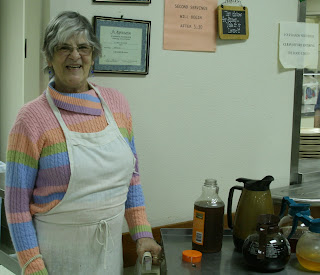On the street, he goes by the moniker "Ninety-nine," and as a black homeless man, discrimination comes in the form of racial slurs from passing cars. As the car disappeared, the words echoed in my brain. But not Ninety-nine's, "There is no quitting," he said.
Ninety-nine chats with Hayseed, in Portland, Oregon.
In a story that was captured during a three-month stint as reporter/investigative journalist for my community, the abuse of homeless is as obvious as the element that homelessness brings. Some abuse power, and some simply have no gratitude.
In Albany, at the Soup Kitchen, where food for dinner is prepared and served three times a week, I found a haven for angels. The men and women volunteers who spend the twenty-plus hours a week cooking and cleaning for the Soup Kitchen, they do it to simply help society out. At one o'clock every Monday, Wednesday, and Friday afternoon, these volunteers arrive at St. Mary's Church, to start preparing dinner.
From slicing fruit to dicing vegetables, to recycling cardboard and washing dishes, the task is substantial. Each dinner takes a dozen volunteers to prepare the food, cook dinner, serve the average sixty people, and then clean the kitchen. The time spent is about seven hours per meal. That doesn't include the daily rounds that some make, gathering food and kitchenware from donators like Walmart, Albertsons, and Starbucks.
Most are gracious for the effort and the good food. In addition to meals, the Soup Kitchen also hands out groceries to the needy. Some of the patrons at the Soup Kitchen would rather steal food, among other things.
The Albany Soup Kitchen at St. Mary's Church on 9th and Ellsworth, dinner at 5p.m. every Monday, Wednesday, and Friday.
Among the up to 100 that eat at the three-times-a-week dinner, many are more than ungracious, they are stealing from the Soup Kitchen itself.
On a recent Wednesday, when Walmart delivers a boxvan of groceries, ranging from 1/2 gallon milks to quality meats, I witnessed no less than three substantial food thefts as well as an Oxford House resident explode after being confronted.
Oxford treatment houses were created in the 1970s by an ex lawmaker, when his own treatment facility lost funding, the lawmaker and resident alcoholic funded the home himself.
The Oxford House is a drug treatment facility that requires community volunteerism and active participation in rehab. Some residents are volunteer workers at the Soup Kitchen because of that treatment requirement. And most do a good job. Some use the kindness of the women that run the Soup Kitchen, to their "advantage" by showing up late, clocking in and leaving, clocking in and not working, and only showing up for the food truck. The last reason is because much of the donated food is handed out as groceries to the needy. In light of this fact, many show up on Wednesday to either steal the food, like Michael Wilde(a problem street alcoholic) did try, or to clock in for treatment and bag up groceries and then leave.
At one point on this particular Wednesday, I watched as a volunteer cook asked the treatment house workers to peel garlic. Nobody moved an inch.
The Soup Kitchen during dinner prep.
One of them muttered, "Not all at once," referring to the table full of Oxford residents.
At a real job, that sort of work ethic would be met with a final check, at the least. Should we ask ourselves if managing drug addicts in a positive, but "stay clean" message, should social responsibilities also be a part of the message? And be included in the treatment?
These are questions that need to be answered. Massive amounts of theft occur in these "communities," such as homeless meals and shelters, and treatment facilities. The amount of disrespect, that the homeless and addiction cultures bring, is costing the the people that deserve the incredible help.
The St. Mary's Soup Kitchen, run for 30+ years, is not the only charity arena with angels and devils. Love, Inc., Albany Helping Hands, Signs Of Victory Mission, all have certain "qualities" in treating the social problem of homelessness. But they all have varying degrees of serious problems.
Addressing those problems is the start of real rehabilitation. The kind of rehab that keeps bodies clean and alive with zest for life and appreciation for those who spurred that second chance at a life other than drugs and streetlife. Some problems, such as Signs Of Victory management being accused of theft, are in need of better leadership. Some, such as the Oxford House resident unable to maintain a gracious attitude in addition to his laziness(Pat, the eldest volunteer at the Soup Kitchen, told him "You don't work."), are in need of stringent rules regarding living in the treatment program.
Integrating social responsibility into the drug treatment will help bring the addict up to speed regarding the interaction with the public. No longer should manipulation, thievery, and violence be the answer. A deep regard for the well-being of other people should be passed along.
Just as it was passed to you.
Marcy and the always present smile. Juice cart included.
This is my first draft- interviews with Oxford House, The City of Albany, and St. Mary's forthcoming.



































































